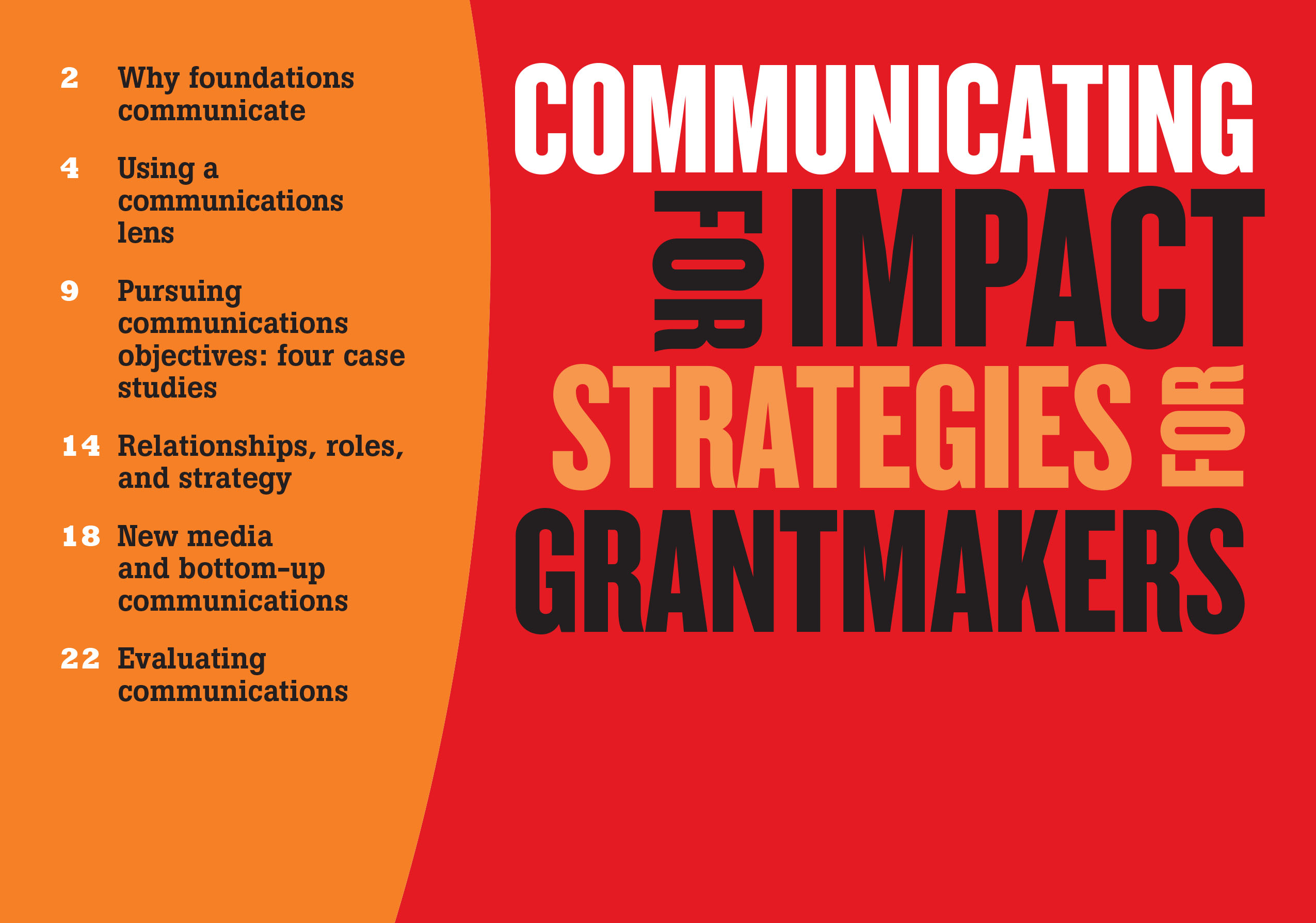Communicating For Impact Discussion Guide for Thoughtful Funder Reflection
These questions pertain to GrantCraft's guide, Communicating for Impact: Strategies for Grantmakers. Read the guide independently. Then, together with your executive, program, and communications teams, dive into the following questions:
Focus on Grantees
1. Who are the key stakeholder groups for your grantees? With which stakeholders are they currently communicating? Which stakeholders are they not currently communicating with but should be?
2. The Commonwealth Fund’s ChartCart (page 7) presents six steps to discuss with your team in planning communications around a given project:
- Program Decisions
- Context
- Strategic Choices
- Communications Activities
- Measurements of Success
- Final Reality Check
What areas do you think your grantees perform particularly well in? What do they struggle with? How can you use this ChartCart to help grantees’ communications impact?
3. Think of a project that you have recently funded and reflect on the following:
- What portion of the grantee’s project budget is currently funding communications?
- What portion of that nonprofit’s staff time is currently focused on communications, and does that staff have the specialized skills required to implement their communications strategy successfully?
- What capacity enhancement and funding support should be built into your foundation’s portfolio budget to support grantees in quality communications?
4. How proficient are your grantees with using social media and what tools are they using, either as individual staff members or as an organization? What are some opportunities for linking grantee social media efforts with the efforts of your foundation to promote the goals of a program portfolio?
5. A longtime grantee is in the midst of a capital campaign, and you want to use a video blast to help them promote it using VirtualSiteVisit.org (page 19).
- What suggestions would you make to your grantee of what to showcase?
- Is there any particular language that they should integrate?
- Who would you blast the video to?
6. Before you can dive in to help grantees, figure out what they already know about communications strategy and tools. What are three methods you could use to learn this?
Focus on Your Foundation
7. Look at Smart Chart’s six steps to planning on page 8.
What part do you feel your foundation does particularly well?
What section has given you trouble in the past?
Action Step: register for free on SmartChart.org to hone your strategy.
8. What is your foundation’s voice? Using our feature on page 3, think about your foundation’s reputation, relationships, and resources. Do so by exploring the following questions:
- What activities, programs, or traditions go hand-in-hand with your foundation's name?
- What relationships have been forged through meetings, events, and staff networks over the last few years? They do not need to be public relationships, just ones with open lines of communication.
- What in-house resources has your foundation used to advance an idea or enable action? Everything from your website to a program-related flyer is fair game.
9. A successful communications strategy requires grantees to be on board as well as grantmakers. What explanations and/or resources might you provide to the nonprofit in favor of more impactful communication to start this conversation about leveraging your relationship?
10. Identify a few goals that both you and your grantee have and how they might overlap. Then, figure out how best to work together:
- What is the best way for your foundation’s program and communications teams to work with a grantee’s program and communications teams?
- What tools will you use to facilitate the collaboration?
- What can you offer that is most in need?
Zoom Out: Strategic Direction
11. In the old paradigm of communication, a foundation’s role was to be the authority; now, it is to be a facilitator. What are some online and offline ways that you can help your foundation to play that role?
12. What steps will you take to assess your internal capacity to help grantees communicate more impactfully? What training, resources, or guidance do you want to share with your program staff? Communications staff? Other staff?
13. In the case study about the Freedom to Marry Collaborative in California, the Haas Jr. Fund supported extensive polling, focus groups, and other research, as well as the creation of a communications toolkit to help their grantees to better target their messages. To what extent do you think the funder can and should be involved in shaping and executing both communications and research strategies in addition to their monetary investment?
Dive In: Building off of examples
14. What grants have your foundation made that simply failed to engage or get their story across? If you had a chance to manage that grantee relationship again, what might you have done differently?
15. In the Robert Wood Johnson Foundation and Benton Foundation case study about the New Routes participatory media project, how do you think the impact of the project is affected by who is producing each segment? Do you think that the impact is more internal to those involved in the project, or can it be externally measured by evaluation techniques?
Elsewhere on GrantCraft
16. GrantCraft enlists guest bloggers (you, our readers to share their wisdom on a variety of topics with our audience. How could guest blogs – either writing them or hosting them – be an effective tool at your foundation? For your grantees?


